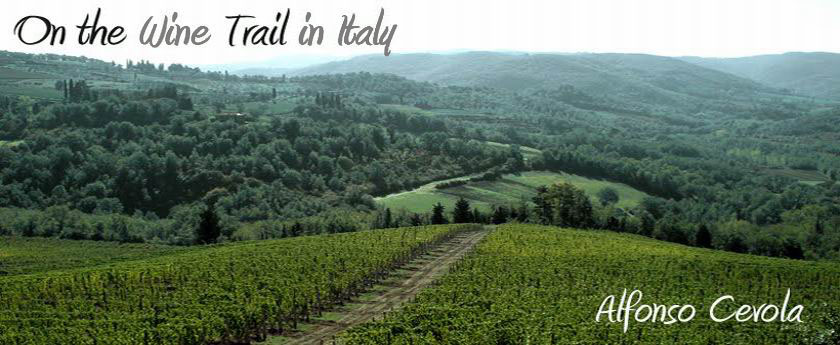Sunday, April 29, 2018
Prosecco: What it is and what it isn’t
Sunday, January 11, 2015
Italy declares war against … radical Prosecco
And while this might seem minute in comparison to more important events unfolding in Europe, this is our smaller march on the wine trail in Italy today.
Sunday, February 04, 2018
Prosecco’s Epic Fail in the New Italian Hotspots in America
Sunday, February 19, 2017
How do you solve a problem like Prosecco?
 |
| How do you catch a cloud and pin it down? Julie Andrews as Maria von Trapp (L) and Sergio Mionetto (R) |
Monday, December 26, 2011
Prosecco vs. the world
 |
| Sergio Mionetto on top of Cartizze |
I don’t have a bone to pick with Prosecco. They are riding high. Price increases are forthcoming, by the way, so the Ferris wheel, she goes up, the Ferris wheel, she also goes down. Rarely does the Ferris wheel stop for one at the top. So there will be challenges in 2012, with an election year in the USA, to move the category forward in double digit growth territory.
Champagne, what do they care? They sell everything they make. Veuve-Clicquot (I was told by a highly placed person in the company) has been in “allocation” mode this year. Regardless of how you fell about any brand of Champagne, one can rest easily knowing the plans the Champenoise have for their brand can take you or leave you. Not so with Prosecco.
Thursday, May 23, 2013
The Battle for Prosecco
Primo is a force, a “big tree,” one of a handful of men and women in landscape of the modern Italian wine revolution who, when you meet them, you know they're playing for keeps. They’re not in it for ego gratification. Primo has an intellectual and artistic side that is equally disarming. We share a love for architecture, both fans of Frank Lloyd Wright. Primo had even been to Scottsdale to Taliesin West. “So you know also of Paolo Soleri?” I asked. It seems we will need to be taking a trip together in the future to visit Arcosanti; Primo hasn't been there.
Sunday, February 10, 2013
What Brunello Can Learn From Prosecco: A Tale of Two Consortiums
In my case I have targeted the consortiums of Brunello and Prosecco in separate posts. They both know how I feel about what is wrong. But things evolve, so let me tell you what I think about their different responses to my lobbing a couple of eggs at them. Let’s start with the one that made an omelet.
Sunday, March 26, 2023
The Four Pillars of Italian Wine
Italian wine is a diverse sea of flavors, colors, buoyancies, styles and price points. There are thousands of grapes, and as many or more wines to go along with it. But what drives the business? What grows the market share? And what keeps the lights on?
It falls to four wines, all with relatively humble
beginnings. The four wines encompass four different types of wines – white, red
, sparkling and sweet. And although they may not be on the tip of the tongues of
today’s tony sommeliers, they provide needed cover for the more esoteric and
trendy wines currently being touted by the in-crowd and influencer-wannabes.Too often we chase the trends and forget what brought us here.
Caution advisory: These are not considered cool wines by the high toned up-and-comers. Those dashers consider them boring, dull, run of the mill, yawn, give-me-a-break, get-away-from-me type of wines. They are misinformed.
Sunday, May 19, 2013
The Hitchhiker’s Guide to Valdobbiadene
Paolo is young, happy, a former winemaker and now working half in Italy and half in the United States representing several wineries. One of them, Cá dei Zago, we met the young winemaker Christian Zanatta at Vinitaly last year. I promised the next time I was in the Valdobbiadene area that I’d be glad to stop by.
Under threatening skies, after several days of heavy rain, we first went to Cá dei Zago. The young winemaker has been fortunate in that his vision of Prosecco and Valdobbiadene corresponds more to how his grandfather saw the land. When I mentioned his name to an enologist at the Conegliano school of enology, he looked at me, startled but pleased, “Ah yes, Christian,” inferring with his words and body language that the young man has tapped into the source of greatness in this area.
Sunday, June 02, 2013
Three Outstanding Prosecco Producers to Seek Out
Three of the wineries are showcased here. Hopefully I will get time to write about the others, but in any event, these three made an impression and I’d like to spend some time noting what it is they do well. These wineries are not in the extremely hilly areas like Cartizze by Valdobbiadene, but they have great exposures and their wines are notable.
Sunday, November 01, 2015
Will the real Franciacorta please stand up?
First off, Franciacorta isn’t Champagne. And Franciacorta isn’t Prosecco. And Franciacorta isn’t something in between Champagne and Prosecco. I’ve heard all of those recently in tastings, and I cringed more than slightly.
Let me dip my pole in the pond and see if we can muddy the water even further.
Thursday, July 09, 2009
DOCG Misfits
 The recent awarding of a DOCG (or was it 2 DOCG’s?) for Prosecco started it all off. I got thinking that there are several wines that have received the DOCG status, that, to me, seem ill fitting. Seeing as I started with Prosecco, let’s start there, shall we?
The recent awarding of a DOCG (or was it 2 DOCG’s?) for Prosecco started it all off. I got thinking that there are several wines that have received the DOCG status, that, to me, seem ill fitting. Seeing as I started with Prosecco, let’s start there, shall we?Conegliano Valdobbiadene and Colli Asolani. Is it one DOCG or is it two? Here we have a classic case of al’Italiana, confusion right from the onset. Most likely it was a political decision, and seeing as we are in Luca Zaia’s backyard, all the more reason for a politician to decide what’s best for the farmers. Good old Dr. Zaia.
 I could understand Conegliano Valdobbiadene a little better than Colli Asolani, but really, is there any Prosecco worthy of a DOCG? If there was, perhaps we might want to consider reserving it for wines that come from the Cartizze, a small and revered spot which is the heart and soul of Prosecco. Maybe a Cartizze would be a laudable rival to one of the great Italian sparkling wines, Franciacorta. But, no, that wasn’t the solution. Why recognize a lion when there are so many asses braying for attention. Let’s give it to them all. But just one problem, say some of the producers. The new law will restrict production, forcing higher prices. Perfect timing for a world where the popularity of Champagne plummets daily.
I could understand Conegliano Valdobbiadene a little better than Colli Asolani, but really, is there any Prosecco worthy of a DOCG? If there was, perhaps we might want to consider reserving it for wines that come from the Cartizze, a small and revered spot which is the heart and soul of Prosecco. Maybe a Cartizze would be a laudable rival to one of the great Italian sparkling wines, Franciacorta. But, no, that wasn’t the solution. Why recognize a lion when there are so many asses braying for attention. Let’s give it to them all. But just one problem, say some of the producers. The new law will restrict production, forcing higher prices. Perfect timing for a world where the popularity of Champagne plummets daily.The reality is, there will be less Prosecco DOCG (or Conegliano Valdobbiadene and Colli Asolani as the politicians have deigned to call it, making it even more confusing) and there will also be a Prosecco DOC. Great. That’s probably what they should have done to Chianti and Chianti Classico, but that’s another paragraph. I wouldn’t want to be a Prosecco producer right now. The folks in Trentino must be having a gay old time with this one.
 A couple of whites (not the only ones, by the way) that I find hard to imagine being DOCG-worthy: Albana di Romagna. What in heaven’s name allowed that to happen? It’s a fine wine to have when one is in the area, but really, is it on the same par as a Fiano or a Gavi? I think not. I tried to grok the wine, and as early as the mid 1980’s I was on to it, looking for every example I could find to determine the mystique of this wine. But, like Galestro, it fell short of fabulous and I couldn’t figure out why the Italian authorities thought this wine worthy of a DOCG. So I chalked it up to a brilliant political maneuver by the communists of the region. I am surprised they haven’t gotten a DOCG for Lambrusco yet.
A couple of whites (not the only ones, by the way) that I find hard to imagine being DOCG-worthy: Albana di Romagna. What in heaven’s name allowed that to happen? It’s a fine wine to have when one is in the area, but really, is it on the same par as a Fiano or a Gavi? I think not. I tried to grok the wine, and as early as the mid 1980’s I was on to it, looking for every example I could find to determine the mystique of this wine. But, like Galestro, it fell short of fabulous and I couldn’t figure out why the Italian authorities thought this wine worthy of a DOCG. So I chalked it up to a brilliant political maneuver by the communists of the region. I am surprised they haven’t gotten a DOCG for Lambrusco yet. The other white, I am sorry to say, is Vernaccia di San Gimignano. I know, I know, Michelangelo, is said to have described the wine he loved and wrote poetry as one that "kisses, licks, bites, pinches and stings". In all the many times I have drunk Vernaccia from San Gimignano I can attest to four out of the five qualities. But kissing? Rarely. Sting, yes. Bites, yes. Pinches, yes. Even licks. But no smooch fest is Vernaccia. So it was given the DOCG for the respect that one gives to an early white DOC? That’s like saying let’s give the part in a new movie to the old star even though the role calls for a younger person. Vernaccia is a minor player in an operetta. Not Puccini and La Boheme or Madam Butterfly or Tosca. No. Not. Ever. Quel dommage.
The other white, I am sorry to say, is Vernaccia di San Gimignano. I know, I know, Michelangelo, is said to have described the wine he loved and wrote poetry as one that "kisses, licks, bites, pinches and stings". In all the many times I have drunk Vernaccia from San Gimignano I can attest to four out of the five qualities. But kissing? Rarely. Sting, yes. Bites, yes. Pinches, yes. Even licks. But no smooch fest is Vernaccia. So it was given the DOCG for the respect that one gives to an early white DOC? That’s like saying let’s give the part in a new movie to the old star even though the role calls for a younger person. Vernaccia is a minor player in an operetta. Not Puccini and La Boheme or Madam Butterfly or Tosca. No. Not. Ever. Quel dommage. While we are rampaging through the Tuscan countryside, let’s tackle Chianti. First, let me be clear. Chianti Classico has a right to the claim of DOCG. Absolutely. But plain vanilla, made in an industrial manner straight Chianti? In Fiasco? What’s up with that? Other than appearing to be totally wrong and sending a very off beam message, it isn’t likely that the powers that be in Italy will ever rescind the DOCG for plain vanilla Chianti. But the whole legitimacy of the Chianti Classico, and even the sub regions, Rufina et al, is compromised precariously. Guilt by association. Hard to keep staying alive. I reckon the lesson that the folks in Bordeaux are learning once again ( the hard way) are not comprehended by their Italian cousins in Tuscany. Might as well be another planet. It too is a shame, because as the world fine wine market is melting down, and we have just seen the tip of the iceberg, the Italians are more interested in their August vacations than the 4th quarter of 2009. Bordeaux is failing and with more revelations to come. Tuscany, well they are waiting in line to get a towel and an umbrella and a beach chair. Bless their hearts.
While we are rampaging through the Tuscan countryside, let’s tackle Chianti. First, let me be clear. Chianti Classico has a right to the claim of DOCG. Absolutely. But plain vanilla, made in an industrial manner straight Chianti? In Fiasco? What’s up with that? Other than appearing to be totally wrong and sending a very off beam message, it isn’t likely that the powers that be in Italy will ever rescind the DOCG for plain vanilla Chianti. But the whole legitimacy of the Chianti Classico, and even the sub regions, Rufina et al, is compromised precariously. Guilt by association. Hard to keep staying alive. I reckon the lesson that the folks in Bordeaux are learning once again ( the hard way) are not comprehended by their Italian cousins in Tuscany. Might as well be another planet. It too is a shame, because as the world fine wine market is melting down, and we have just seen the tip of the iceberg, the Italians are more interested in their August vacations than the 4th quarter of 2009. Bordeaux is failing and with more revelations to come. Tuscany, well they are waiting in line to get a towel and an umbrella and a beach chair. Bless their hearts. Last one- Bardolino Superiore. Now I like Bardolino and I love the Chiaretto. But the wine is a romp, a fun time, a fast ride with the windows down. Bardolino is a hot date with a cute blond in a mini. But there is no gravitas attached to it. Bardolino is a summer affair, while the faithful spouse, let’s call her Amarone, sits at home and waits. And feeds the kids. And is full of character. Yes, Bardolino is fine as a DOC, but no “G’, no “G”. Ah gee.
Last one- Bardolino Superiore. Now I like Bardolino and I love the Chiaretto. But the wine is a romp, a fun time, a fast ride with the windows down. Bardolino is a hot date with a cute blond in a mini. But there is no gravitas attached to it. Bardolino is a summer affair, while the faithful spouse, let’s call her Amarone, sits at home and waits. And feeds the kids. And is full of character. Yes, Bardolino is fine as a DOC, but no “G’, no “G”. Ah gee.It is July and I’m entering that period where the sun beats down on my head and funny ideas emerge. But the Italians have me beat with their misfit decisions about which wines should and shouldn’t be the standard bearers for the country. Greed, politics, back room haggling, deals made in smoky chambers, in a word, politics.
Like I said, quel dommage.

Sunday, January 26, 2020
Has the battle for Italian wine in high-traffic retail been lost?
So, let’s dig in and take a look at this situation.
Sunday, June 25, 2006
The 31st of June
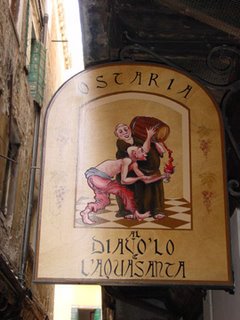 In the Veneto, legend has it that a monk got into a little trouble with the devil. The monk, Fra Stefano, wanted to make the greatest wine that had ever been made. Inspired by the miracle at Cana when Jesus turned water into wine, this monk filled his barrels up with holy water and called upon an unothodox power to help transform this into wine. A certain fellow, but a diabolical one at that, came upon the scene and offered to help this monk in exchange for his soul. This being harvest time and the monk wishing to enjoy the fruits of his labors, he bartered with the devil to let him have his soul until the end of spring. Now this monk wasn’t too good with time and numbers and when pressed by the devil for a definite date, the monk said, “the 31st of June”. At which time he and the devil made their deal. It seems the devil was none to good at time and numbers as well. But a deal is a deal even when one makes it with the devil. Oh, what a good wine it was!
In the Veneto, legend has it that a monk got into a little trouble with the devil. The monk, Fra Stefano, wanted to make the greatest wine that had ever been made. Inspired by the miracle at Cana when Jesus turned water into wine, this monk filled his barrels up with holy water and called upon an unothodox power to help transform this into wine. A certain fellow, but a diabolical one at that, came upon the scene and offered to help this monk in exchange for his soul. This being harvest time and the monk wishing to enjoy the fruits of his labors, he bartered with the devil to let him have his soul until the end of spring. Now this monk wasn’t too good with time and numbers and when pressed by the devil for a definite date, the monk said, “the 31st of June”. At which time he and the devil made their deal. It seems the devil was none to good at time and numbers as well. But a deal is a deal even when one makes it with the devil. Oh, what a good wine it was! * * * * * * * * * * * * * * * * * * * * * * * * * * * *
A young man arrived in the Veneto, in a small town where the Prosecco wine is made.
 The town, Rolle, is very near the epicenter of the Prosecco heartland, Valdobbiadene. He had read about this area for some time now, the prospect of anticipation was now a reality.
The town, Rolle, is very near the epicenter of the Prosecco heartland, Valdobbiadene. He had read about this area for some time now, the prospect of anticipation was now a reality.As he settled in his room for the night, in an inn that had once been an abbey, he felt a serene familiarity with his surroundings. It was as if he had been reminded of something that hadn’t yet happened.
Valdobbiadene and the surrounding area is a fantasy land for wine and food lovers.  One hour or so from Venice, but light years from the tourists and the hype and the come on. No menu turistica, no pizza, no gondolas. There is something wonderful about the sound of the church bell ringing at 6:45 in the morning calling the people to mass and the workers to their labors. As it has been for centuries. Roosters crow, doves coo and cuckoos announce the dawn add to the symphony of the hills. There is a peace in these valleys that resonates in ones soul long after one is back home.
One hour or so from Venice, but light years from the tourists and the hype and the come on. No menu turistica, no pizza, no gondolas. There is something wonderful about the sound of the church bell ringing at 6:45 in the morning calling the people to mass and the workers to their labors. As it has been for centuries. Roosters crow, doves coo and cuckoos announce the dawn add to the symphony of the hills. There is a peace in these valleys that resonates in ones soul long after one is back home.
The wine is simple. It’s white and often bubbly. Fresh and lightly fruity. Now it is fashionable in places like San Francisco and New York, but fashion from this place seems odd. The spirit of here whispers, “Timeless”. Some of the winemakers the young man will visit are Mionetto, Montesel and Bisol, all from the land of the Valdobbiadene.
The problem with fashion is that it overlooks the 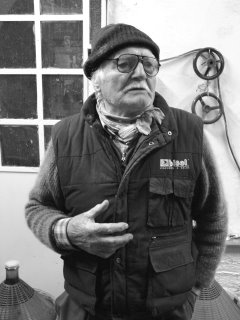 timeless for the new. Our societies in Italy and America are rapidly paving over the traditions once held in high regard. And with it go the people and the stories. People like Giuseppe, who owns a small plot of land clinging to a hill in Valdobbiadene. An octogenarian who rises at four in the morning to go out and work in his vineyard. The children have moved away to Milan to become accountants and pharmacists. They will never get home by the 31st of June. His way is dying and he tells me he fears this way of life will go when he goes. No legacy buyout from a corporation wishing to further his work into the future.
timeless for the new. Our societies in Italy and America are rapidly paving over the traditions once held in high regard. And with it go the people and the stories. People like Giuseppe, who owns a small plot of land clinging to a hill in Valdobbiadene. An octogenarian who rises at four in the morning to go out and work in his vineyard. The children have moved away to Milan to become accountants and pharmacists. They will never get home by the 31st of June. His way is dying and he tells me he fears this way of life will go when he goes. No legacy buyout from a corporation wishing to further his work into the future.
Sergio  Mionetto sold his company some time ago but remains with the company as their spokesman and spiritual compass. The company now embraces modernity and innovation, hoping to reach a larger audience of Prosecco-isti. Sergio, meanwhile, has become a living symbol of those hills, etched on his face like the gulleys of his beloved Cartizze, a small drop of a land that is thought to be a place where the terroir of the Prosecco has its greatest potential. Only 106 hectares. Here the land is some of the most valuable in Italy, valued at $1,000,000 euro per hectare. On this land are more souls who work the land, become the land, who breathe out of that soil nectar that seldom is found in the land. Sell their land? Not likely.
Mionetto sold his company some time ago but remains with the company as their spokesman and spiritual compass. The company now embraces modernity and innovation, hoping to reach a larger audience of Prosecco-isti. Sergio, meanwhile, has become a living symbol of those hills, etched on his face like the gulleys of his beloved Cartizze, a small drop of a land that is thought to be a place where the terroir of the Prosecco has its greatest potential. Only 106 hectares. Here the land is some of the most valuable in Italy, valued at $1,000,000 euro per hectare. On this land are more souls who work the land, become the land, who breathe out of that soil nectar that seldom is found in the land. Sell their land? Not likely.
A visit to a farm in the hamlet where the Prosecco of Cartizze is grown. Here in 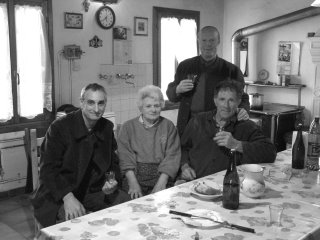 this land one doesn’t find over stuffed mansions of 10,000 square feet with 5 bedrooms and 6 bathrooms, for only two people. Here is a small house with a wood burning oven, home made bread, cheese and wine. And two very content and happy people who live there. Looking at the purity of their smiles, the clarity in their eyes, the simplicity of their lives, these are people rich beyond the value of their land, wealthy beyond trust funds.
this land one doesn’t find over stuffed mansions of 10,000 square feet with 5 bedrooms and 6 bathrooms, for only two people. Here is a small house with a wood burning oven, home made bread, cheese and wine. And two very content and happy people who live there. Looking at the purity of their smiles, the clarity in their eyes, the simplicity of their lives, these are people rich beyond the value of their land, wealthy beyond trust funds.
During the early spring the winemakers 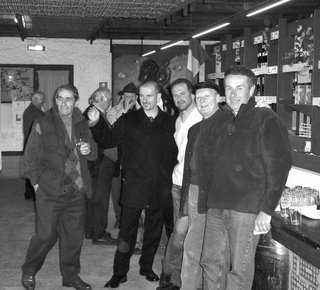 put on an exhibition of their wines in the
put on an exhibition of their wines in the
little towns. In one of these Sergio gathers with some of his friends and colleagues, journey men and apprentices. A modern day guild of sorts, this one to celebrate the miracle of grapes into wine. Without the devil and the holy water. Who wouldn’t want to be part of that happy gathering? What a life!
 Renzo Montesel started as an agronomist for the region. On the outer edge of the Valdobbiadene zone, in Colfosco, He and his wife have a small farm. Their vineyard, the Vigna Paradiso, sits on tufa rock, porous soil that has excellent drainage and exposure. The wine has an infinitely fine mousse. These are younger people and with them comes the hope that some of the living legacy of the elders will live on in the labors of Renzo and his wife Vania. Their wine is ‘hand-made’ and rivals the best the region has to offer in Prosecco.
Renzo Montesel started as an agronomist for the region. On the outer edge of the Valdobbiadene zone, in Colfosco, He and his wife have a small farm. Their vineyard, the Vigna Paradiso, sits on tufa rock, porous soil that has excellent drainage and exposure. The wine has an infinitely fine mousse. These are younger people and with them comes the hope that some of the living legacy of the elders will live on in the labors of Renzo and his wife Vania. Their wine is ‘hand-made’ and rivals the best the region has to offer in Prosecco.The Bisol family is equally understated in
 their outward appearances, but here is where the Prosecco finds an anchor. One of the largest landowners in the Cartizze (they hold 3 hectares) and gregarious in their reach. Their vines cover 50 hectares (where the average vineyard holding is 1 hectare); their family offers wine growing classes, wine tasting seminars and traditional cooking courses from their hospitality center, the Foresteria Duca di Dolle. Here one can lose oneself, or perhaps really find ones true reason for being. The opportunity is here in many ways.
their outward appearances, but here is where the Prosecco finds an anchor. One of the largest landowners in the Cartizze (they hold 3 hectares) and gregarious in their reach. Their vines cover 50 hectares (where the average vineyard holding is 1 hectare); their family offers wine growing classes, wine tasting seminars and traditional cooking courses from their hospitality center, the Foresteria Duca di Dolle. Here one can lose oneself, or perhaps really find ones true reason for being. The opportunity is here in many ways.And tonight this young man on his way back from several days out in the field with these beacons of inspiration. On his way back to the room he picks up a book, about an older man of the village. His life, his story, this man who after a period of traveling while young, came back to this little village and lived his life. How oddly familiar this story was to the young man, but only in the way one can sense something that might be about to happen, what they call déjà vu.
The next morning the young man, sitting out among the vineyards taking in the morning, was filled with light and an understanding of the cycle of the old mans life and his, entwined like the vines and the poles holding them up. As the church bells tolled, it was as if the life of the grapes made to sparkle infused within him to the point of immersion into the territory. He was becoming part of the terroir as a flower would bloom, a bird would sing.
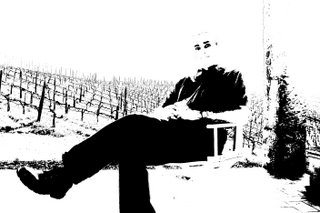
It was then the young man knew that book about the old man's life was about the life he was about to start living, in an amazing place, in the hills above Venice.
June 31st had arrived.
* * * * * * * * * * * * * * * * * * * * * * * * * * * *
RESTAURANTS IN ROLLE
In this small, fascinating borgo there are two very renown restaurants: Da Andreetta and Locanda al Monastero, where it is possible to taste some fine local dishes, according to the culinary tradition of the Prosecco hills.
Seasonal products are an extremely important ingredient in the preparation of the menus: Mushrooms, Treviso Red Chicory, Spontaneous Wild Herbs, Asparagus, cheese from the Pre Alps, are just a few of the options available to the chefs. Wonderful al fresco dining in summer and excellent fireside dining in winter.
Ristorante da Andreetta – Terrazza di Rolle
Address: Via Enotria 7 Rolle (Treviso)
[this web site has additional information on Rolle ]
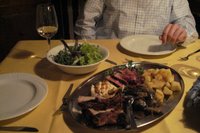 Locanda al monastero
Locanda al monastero
Menu changes daily according to the seasonal offerings. My vote for last meal on earth. Address: Via Enotria 21 Rolle (Treviso)
 RESTAURANT IN MAINE
RESTAURANT IN MAINE
Ristorante 'Da Gigetto'
An absolute pilgrimage to a shrine for food and wine. One of the best experiences I have ever had.
via A. De Gasperi, 4.31050 Maine
Trevisio
Italy
STAY IN ROLLE
A relaxing and pleasant stay at the “Foresteria Duca di Dolle” will be an unforgettable experience, where enjoying fine wine and cooking classes, visits to artistic sites and excellent local restaurants, mountain biking, walking, where getting what every body is looking for: the perfect balance between mind and body, can transpire.
LOCAL & REGIONAL FOOD FESTIVALS (SAGRAS) TREVISO PROVINCE
This land invites you to celebrate the joy of life. The gourmets will find their paradise in this area: in any season, local products are used to create fine typical dishes, and are presented in excellent restaurants and unique gastronomic festivals held all over the Treviso Province. Festivals are just some of the many interesting events to take part in while visiting Rolle.
Cocofungo (mad for mushrooms) - October
Cocoradicchio (mad for radicchio) - Febrary
The Radicchio di Treviso Festival - December
The Combai Chestnuts Festival - October
The Prosecco Spring Festival March - June
Amopesce (fish festival in April)
Riso e Verdiso… - middle of May
The Mostra Nazional degli Spumante Exhibition - September (held at the beautiful Villa dei Cedre in Valdobbiadene. An Italian Exhibition of over a thousand extraordinary, unique and sparkling wines).
Vino in Villa - last week-end of May (organized from Consorzio Prosecco of Conegliano-Valdobbiadene)
producers
Mionetto
Via Colderove, 2
Valdobbiadene 31049
Tel: 0423.9707
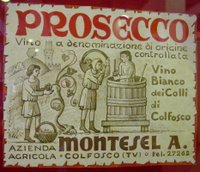
Montesel
Via S. Daniele 42
Colfosco Di Susegana, 31030
Tel: 0438.781.341
no web site
Bisol
S. Stefano di Valdobbiadene 31040
Tel: 0423.900.138
Sunday, December 14, 2014
What New World Sommeliers Need to Know About Old World Italian Wine
Sunday, December 30, 2012
The Rape of the Veneto
“What happened in Montalcino earlier this month was horrendous, but as bad as it was, it paled in comparison to what has been going on in the Veneto. They have virtually raped the land, stripped it of any character in pursuit of dollars. The popularization of Prosecco has had enormous effect on people, on farming, on the earth.”In review of events that have transpired in Italy this year, the perversion of Prosecco persists. Enormous growth year after year has people chasing after more and more profit, pushing the land, changing laws, reducing the Veneto to a mere factory for the whims of folks who no longer want to spend money on Champagne and sparkling wine of character.
Many of us were struck by the harshness of the act that one man perpetrated early one morning in December in Montalcino. It was horrid, indeed. But the systematic dismantling of tradition in the Veneto, from Valdobbiadene and Conegliano, on the gentle slopes that humankind has lovingly nurtured - that is tragedy of legendary proportions. Culture, tradition, quality, values - all receding like the arctic ice in the Polar zones.
Sunday, December 08, 2019
“喜劇結束了” - The State of Italy - Wine, Culture, All of It - in 2120
Assisi - February 14, 2120 A.D.
Where to start? As everyone knows by now, around 2040, things got tough for Italians in these parts. The Chinese population alone in Tuscany was nearing 500,000, displacing many generations of Tuscans who died in the 1st Pandemic of 2020. Along with that, the birth rate declined so extensively that it was hard to keep some of our industries going. Native manufacturing all but disappeared. And farming wouldn’t have survived if not for AI. Vineyards began to shrivel, with no one to work the land. And then, as if overnight, we found out that China owned 58% of Italian land and industry. We had been invaded, overrun and taken over by our own hubris and inertia. Now we are a colony.
Thursday, March 24, 2011
Italian Wine DOCG News - Now up to "60"
 |
| Carnac the Magnificent. by Victor McCay |
Still waiting at the altar
· Montepulciano d' Abruzzo Casauria (or “Terre di Casauria”)
· Prosecco di Prosecco (political appointment for the town of Prosecco in Friuli)
So with ten (10) cats a herded, that would make the magic number, at this point in time and space a total of 59 (*with the proviso that the two in asterisks have not yet been published in the Gazzetta Ufficiale, so they are awaiting their "official" notification, which is somewhere down in the "administrative" queue) ...listing after the break
Sunday, October 11, 2009
The Best Italian DOCG list? (now up to 47)
 In my research, it has been all but impossible to pinpoint the complete list of Italian DOCG wines. Recently, I have been able to find six more, Moscato di Scanzo, Elba Aleatico Passito and Prosecco Superiore Conegliano Valdobbiadene, Prosecco Superiore Asolo And a two Marche DOCG's of Verdicchio of which there are designations for Verdicchio di Matelica and Verdicchio dei Castelli di Jesi Classico (and riserva) , bringing the list up to 47.
In my research, it has been all but impossible to pinpoint the complete list of Italian DOCG wines. Recently, I have been able to find six more, Moscato di Scanzo, Elba Aleatico Passito and Prosecco Superiore Conegliano Valdobbiadene, Prosecco Superiore Asolo And a two Marche DOCG's of Verdicchio of which there are designations for Verdicchio di Matelica and Verdicchio dei Castelli di Jesi Classico (and riserva) , bringing the list up to 47.If anyone knows of any more DOCG wines, or if there is a list available that is more complete or accurate, please feel free to contact me. I have looked on the Italian Trade Commission site; they still list only 35 wines. Wikipedia lists 36 wines.Winecountry.it only lists 32 wines. Luca Zaia’s website has nothing on the DOCG, but he’s just the minister of agriculture, why would he need to have one? I guess having seven Facebook pages (one personal and six groups, sorry you have to be a member to follow the link) makes up for it. There’s nothing to be found about it on the Italian Wine Merchants site, but then again, they make no claims to be the best educational site for Italian wines, just this statement, “Since 1999, Italian Wine Merchants (IWM) has worked diligently to demystify Italian wine through its detailed website and weekly E-letter, Wine Clubs, educational tasting events and a carefully selected portfolio of current and vintage Italian bottlings.” But no demystifying by listing a current and complete DOCG list can be readily found on their site.
Update: Tomas E. of the Wikipedia Project wine also has this nifty document, where on pages 40-41 you can find the 41 DOCG wines listed.They also have yet to put up the Elba Aleatico Passito and the Moscato di Scanzo but by the time this gets posted, they might already have it updated. Thanks Tomas!)
The best site so far is in Italian, Agraria, which has 41. Please do not write me and tell me that they have 43 because that is what you counted. They have Moscato d'Asti listed separately, but it falls within the Asti DOCG, OK? Also at the end they list Vin Santo. At this time it is not DOCG. They also do not have the three new DOCG's (that I know of) listed on their site(as of March 22, 2009).
Update 2: Luca Zaia has brought in another DOCG for Prosecco. Read about his accomplishments and achievements here. Thanks to Laura De Pasquale for the info. And thank you, Dr. Zaia!
I fear I am missing something, but for the life of me, the byzantine workings of the Italian government and the folks who determine which wines will be awarded DOCG status eludes this most ardent researcher. I guess I haven’t learned the secret handshake. Until then, we are at either 46 wines or 48, as of October 10, 2009, which have been given DOCG status. Here is the list, after the jump.
Complete Listing of Italian DOCG Wines (as of October 2009) : 47
Abruzzo (1)
Montepulciano d'Abruzzo "Colline Teramane"
Campania (3)
Fiano di Avellino
Greco di Tufo
Taurasi
Emilia Romagna (1)
Albana di Romagna
Friuli-Venezia Giulia (2)
Colli Orientali del Friuli Picolit
Ramandolo
Lazio (1)
Cesanese del Piglio
Lombardia (5)
Franciacorta
Oltrepo Pavese
Sforzato della Valtellina
Valtellina Superiore
Moscato di Scanzo (new)
Marche (4)
Conero
Vernaccia di Serrapetrona
Verdicchio di Matelica Riserva (new)
Verdicchio dei Castelli di Jesi Classico Riserva(new)
Piemonte (12)
Asti spumante - Moscato d'Asti
Barbaresco
Barbera d'Asti
Barbera del Monferrato Superiore
Barolo (Chinato, as well, falls under this DOCG)
Brachetto D'Acqui o Acqui
Dolcetto di Dogliani Superiore o Dogliani
Dolcetto di Ovada Superiore
Gattinara
Gavi o Cortese di Gavi
Ghemme
Roero (Rosso & Bianco)
Sardegna (1)
Vermentino di Gallura
Sicilia (1)
Cerasuolo di Vittoria
Toscana (8)
Brunello di Montalcino
Carmignano
Chianti
Chianti Classico
Elba Aleatico Passito (new)
Morellino di Scansano
Vernaccia di S.Gimignano
Vino Nobile di Montepulciano
Umbria (2)
Montefalco Sagrantino
Torgiano Rosso Riserva
Veneto (6)
Bardolino Superiore
Recioto di Gambellara
Recioto di Soave
Soave Superiore
Conegliano Valdobbiadene Prosecco Superiore (new)
Asolo Prosecco Superiore (new)
Thursday, May 16, 2013
Italy is “Open for Business”
Tasting everything from Moscato to Arneis, Pelaverga to Barbaresco, Barolo to Amarone and now in Friuli, Pinot Grigio to Tocai. Today is the last day in Friuli before heading back to the Veneto and Valdobbiadene for the Vino in Villa event. It’s a bit of a blur, and the beat goes on.
